9 Tips For Decanting Wine, According To A Sommelier
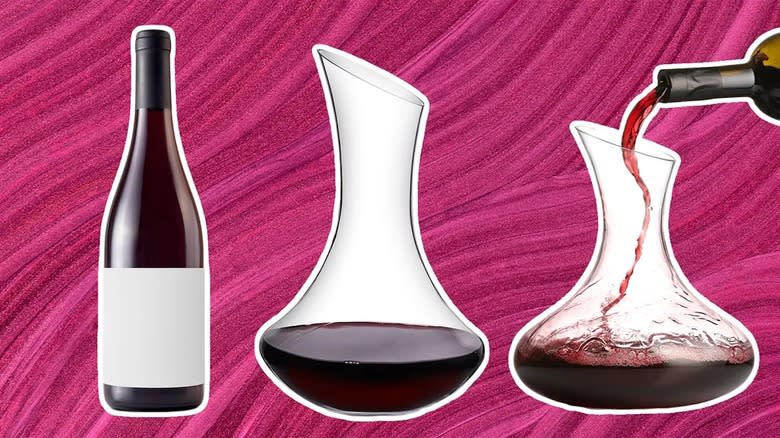
We may receive a commission on purchases made from links.
Nothing beats a bottle of wine with dinner. But you want your wine to have the best possible flavor and scent, especially if it's a vintage red wine. In order for that to happen, you should aerate it. We all know the trick of letting a bottle of red sit on the counter and breathe before serving it, but if you really want that wine to shine, the best thing to do is pour it into a decanter. Because a decanter has a wider mouth than a bottle, you'll get a lot more oxygen into the wine. That oxygen mellows out the sharp tannins and harsh acidity in younger vintages while allowing the flavors to bloom in older bottles.
Even though you could just dump the wine straight into the decanter, we figured someone who has studied wine and serves it for a living would probably have some great pointers. Luckily Peggy Kearns Dean, DipWSET, a sommelier at Pacific Standard Prime in Redondo Beach, and Cheryl Lassen from Mastro's in Beverly Hills, were nice enough to sit down with us and give their recommendations on how to get the most out of your decanter and the wine in it.
Read more: 15 Popular Hard Seltzer Brands, Ranked Worst To Best
Keep Older Bottles Of Red Wine Upright For 24 Hours
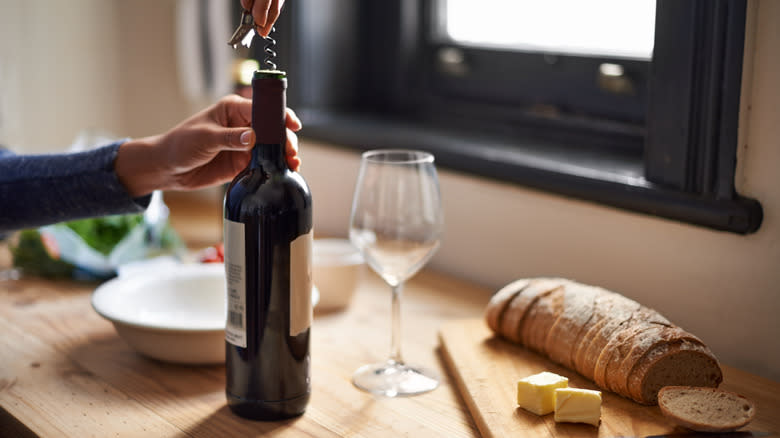
One of the best ways to store bottles of wine is on their side. Keeping the bottles horizontal keeps the cork moist and no oxygen sneaks inside. The bottles can stay that way for years, especially if they're kept in a cool environment. Even though keeping the bottles horizontal prevents the wine from oxygenating, it doesn't prevent sediment from accumulating in the bottles and even clinging to the cork. That sediment is usually just tiny bits of grape skins and tannins bonding together with tartrate acid crystals. "They're harmless, but they're not very pleasant to taste," explains Peggy Kearns Dean.
Since most people only want to enjoy the wine and not the sediment you often find in red varietals, she says the best way to prepare the bottle for drinking, is to stand it up vertically on the counter for 24 hours before opening it, especially if it's a red wine over 10 years old. That way all the sediment that has built up over the years settles in the bottom of the bottle rather than in the bottom of your glass.
Pour The Wine Under A Light So You Can See The Sediment
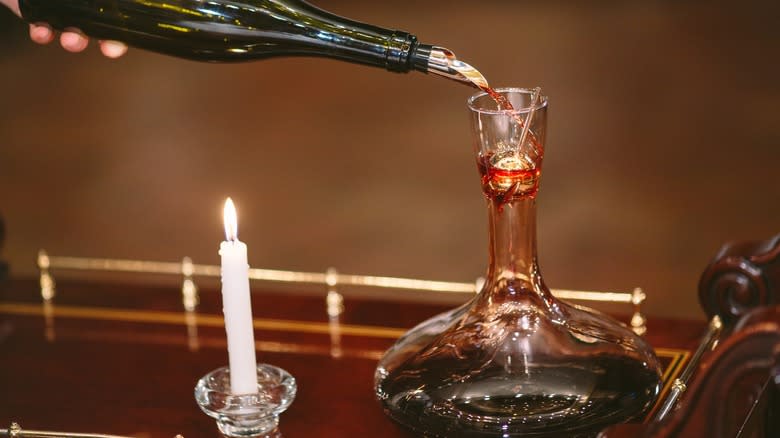
How many times have you been enjoying your cabernet or merlot, only to notice a thin film of sludge at the bottom of your glass? That's the sediment we mentioned earlier. Since no one wants that film in the bottom of their wine glass, Peggy Kearns Dean recommends using a light as you transfer red wine from the bottle to the decanter. It doesn't matter what kind of light you use, as long as it's bright enough to see the sediment inside the bottle.
Pouring the wine in front of a strong light allows you to not only see the sediment but watch as it creeps from the bottom up to its neck. So, Dean recommends taking your time. You don't need to rush the transfer as it's all part of the experience. Once the sediment reaches the neck of the bottle, "you'd want to stop pouring," Dean explains. "There'll be a little bit of wine left [in the bottle] but you have to just, you know, forget about that," she says with a smile.
Decanter Sediment Screens Will Keep The Sediment Out Of Your Wine
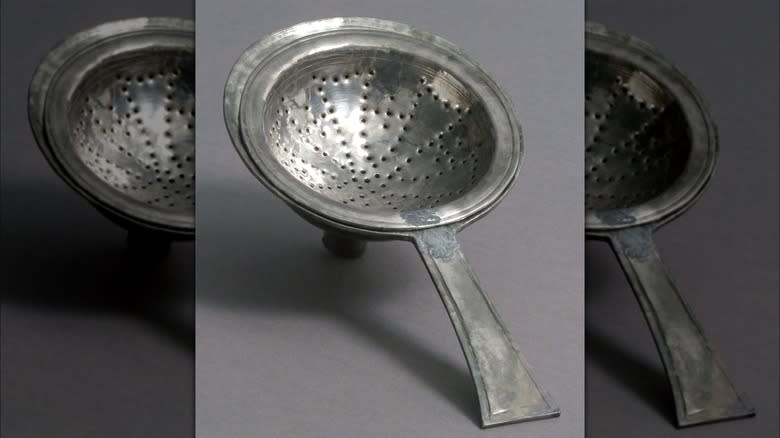
If you don't want to take the time to find and set up a light source, Peggy Kearns Dean says there's a simpler way to keep that pesky sediment out of your decanter: buy a screen. "They have these great little screens, metal screens, that you can put on the mouth of the decanter," she explains.
Available on Amazon in all shapes and sizes, these screens act like a sieve, catching all those little bits of sediment while allowing the luscious wine to slip through into the decanter. Some even include a funnel so the aeration process begins the minute you start pouring the wine into the decanter.
But no matter which type of screen you pick, they're a simple answer to the sediment issue. And they're cheap. We found several for under $20. Dean says using these screens is an "easier and more foolproof" option than trying to weed out all those bits on your own.
Pour The Wine Down The Side Of The Decanter To Help Aerate It
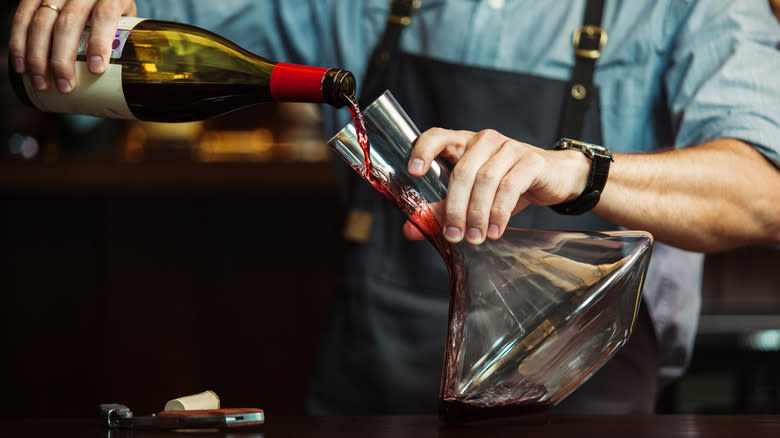
As we mentioned earlier, the point of decanting a bottle of wine is to get as much air into it as possible to open up the flavors and aromas of said wine. Since we don't just taste with our mouths and tongues, but with our noses and eyes, those delectable smells and sights prepare our taste buds for the wonderful beverage. Even though pouring the wine into the decanter is a great start to that process, how you pour the wine is just as important.
"You definitely want to aerate the wine to get as much oxygen as possible, and you want to do it quickly," explains Cheryl Lassen. "So being on the side of the decanter helps it efficiently go down and it helps aerate it faster." It's also beautiful to behold. When done correctly, the wine spreads across the glass like a silk scarf billowing in the wind. It covers the inside of the decanter, creating an even larger surface area for the air to get to.
If You Don't Have A Decanter, A Pitcher Will Work In A Pinch
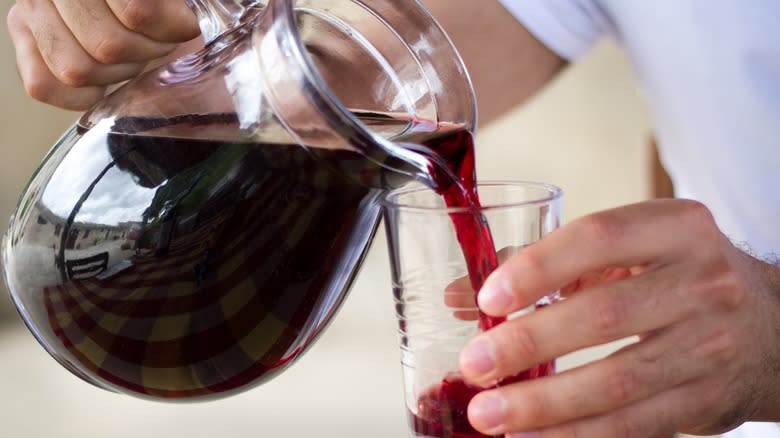
Available in all shapes and sizes, decanters are stunning to behold. Usually made of glass, these fancy instruments can be quite expensive. Then there's the issue of storage. Because they're meant to hold at least one to two bottles of wine, decanters can be pretty big, which means finding somewhere to store them can be tricky. So, if you don't like to entertain or just don't want to spend the money, but still want to get the most flavor out of your wine, Peggy Kearns Dean has an "easy trick" she often uses. It requires a basic kitchen tool that you probably already have it hidden in the cabinet: a pitcher.
"If I have people, friends, coming over or am bringing a bottle of wine to a tasting or somebody's house, I'll dump that bottle of wine in the pitcher and let it sit for maybe an hour," she says. "Then I'll funnel it back into the bottle and set it out on the dinner table so nobody knew it was in a pitcher," Dean adds. The benefit of using a pitcher is twofold: You aerate the wine as it's being poured into the pitcher and then, because pitchers tend to have a wider mouth than the bottle's neck, the wine continues to freshen up as it sits out.
Wine Glasses Will Aerate The Wine Just As Well As A Decanter

Have you ever been preparing a meal and discovered that the recipe calls for a splash of wine? Or maybe as you're preparing that wonderful meal, you realize a glass of wine would really enhance the dining experience. The only problem is, you don't necessarily want to drink the whole bottle. These are the times that Peggy Kearns Dean suggests pouring a glass or two and leaving it on the counter. "A lot of times, if I know I'm having red with dinner," she explains, "I'll pour a glass for me and my husband, just sit it on the counter for a while because it's breathing in the glass."
While the red wine breathes, you can finish making dinner or even enjoy a glass of sparkling wine or a cocktail. Then 30 minutes or an hour later, once dinner's prepared, and you're ready to sit down and eat, the wine that's been sitting in the glass is ready to be sipped and enjoyed. The best thing about this decanting method is that while the wine has had a chance to freshen up, Dean says you've "still preserved the rest of the bottle for another day."
Let The Wine Sit In A Decanter For At Least 15 Minutes Before Drinking It
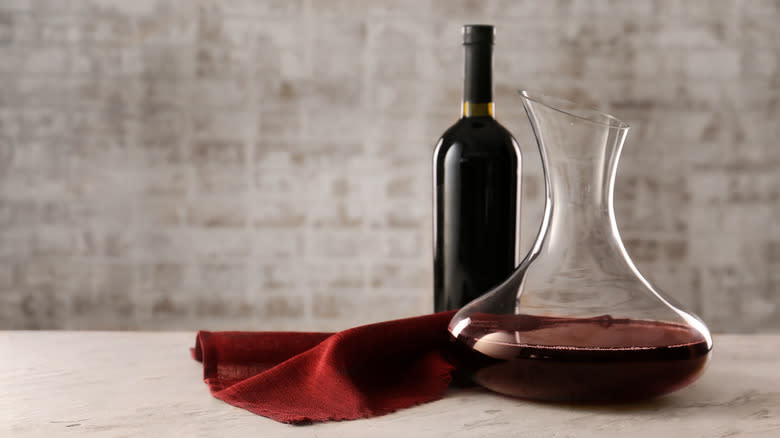
Dinner's ready, you've grabbed your favorite bottle of wine and you've poured it into your favorite decanter. Now you have to let it sit. The only question is how long? Well, that depends on the wine and what you prefer. Peggy Kearns Dean says you don't want to wait too long if it's an older wine, maybe 15 minutes.
"You don't want too much oxygen getting into that one because it can just go downhill," she explains. Over aerating an aged wine can cause it lose both flavor and aromatic compounds. Most importantly, once you've started drinking it, make sure to finish the bottle because Dean says it simply won't taste good the next day.
On the other hand, with younger wines, Dean suggests tasting it every 30 minutes. Once it's to your liking, then go ahead and fill that glass. "That's fun too," she reveals, "because you see the wine develop." So, while the wine may taste one way with your first glass, given more time in the decanter the wine has had more time to breathe, which means the second glass you have later could reveal different flavors from the first. There isn't a firm rule about time, Dean says. It all comes down to what you prefer.
Whatever You Do, Don't Use Soap To Clean Your Decanter
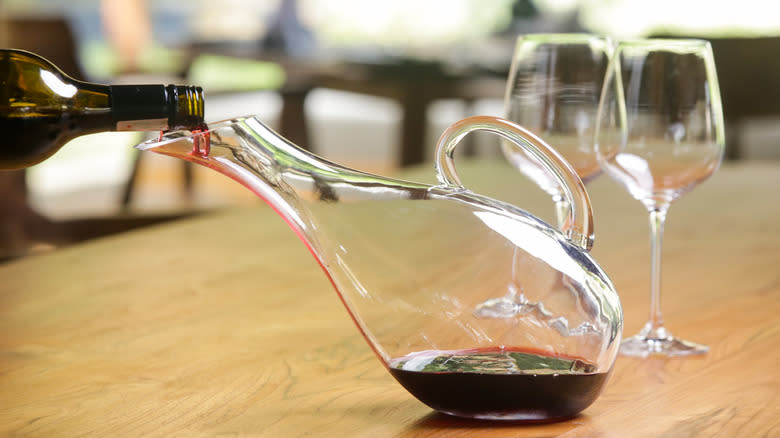
There's no denying that wine decanters are beautiful. Often made of crystal and twisted into stunning shapes, these special pitchers add an air of elegance to any dinner party. While they improve the taste of any wine poured into them, they do present one problem: cleaning. Those intricate shapes and long necks make them very difficult to clean. You need a long brush to snake down the neck and there are even special decanter beads you can purchase. The one thing you don't need? Soap. Peggy Kearns Dean says soap could ruin the decanter.
"You want to use hot water, which will kill germs and get rid of any residue," she says. The other key to keeping your decanter fresh and ready for the next bottle of wine is to make sure that you clean it as soon as possible. "You don't want the wine to just sit in there," Dean explains, "because then it's just going to get harder to clean." But if you want to ensure you're cleaning your decanter correctly, Dean recommends doing a little research on the specific model, which is pretty easy these days since she says most decanters come with cleaning instructions.
If You Don't Finish A Younger Wine, Pour It Back Into The Bottle

While we mentioned it's okay to decant a couple glasses of wine, if you do end up decanting the whole bottle, but don't finish it, Peggy Kearns Dean says you don't have to dump the remaining wine. It does, however, depend on the type of wine you decanted. "With the older wine, you definitely want to finish that within a day," she explains. That way you'll guarantee it will taste as good as it did when you first opened the bottle.
But it's if it's a younger red or white wine, the sommelier says it's okay to funnel it back into the bottle, replace the cork, and store it in the fridge. Then when you're ready to finish it the next day, simply pull it out, remove the cork, and bring it back to room temperature (if it's a young red). Dean says that will "preserve" the wine.
Whatever you do, do not store it in the decanter. Keeping it in the decanter will only allow more oxygen to seep into the wine and cause it to turn quickly. Storing the wine in a resealed bottle though, guarantees it will hold onto its delicious flavor for at least another day or two.
Read the original article on Tasting Table

